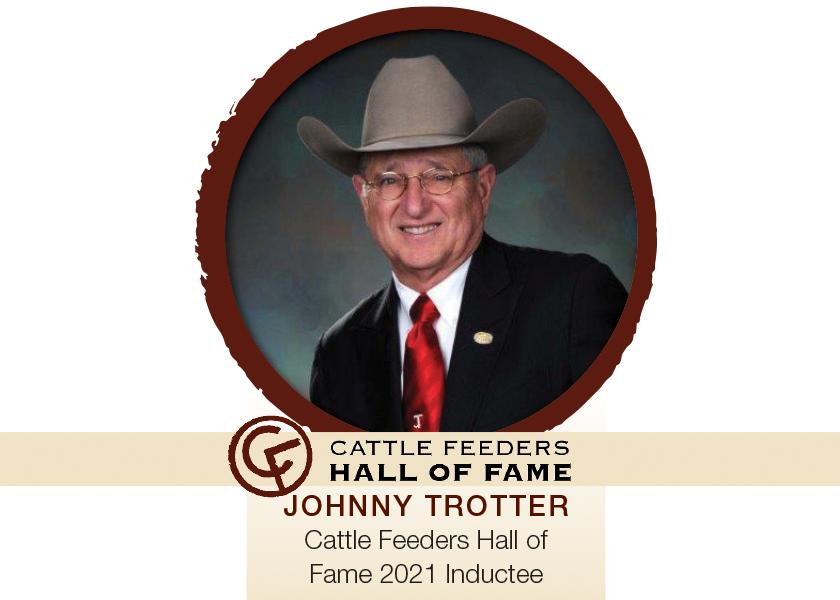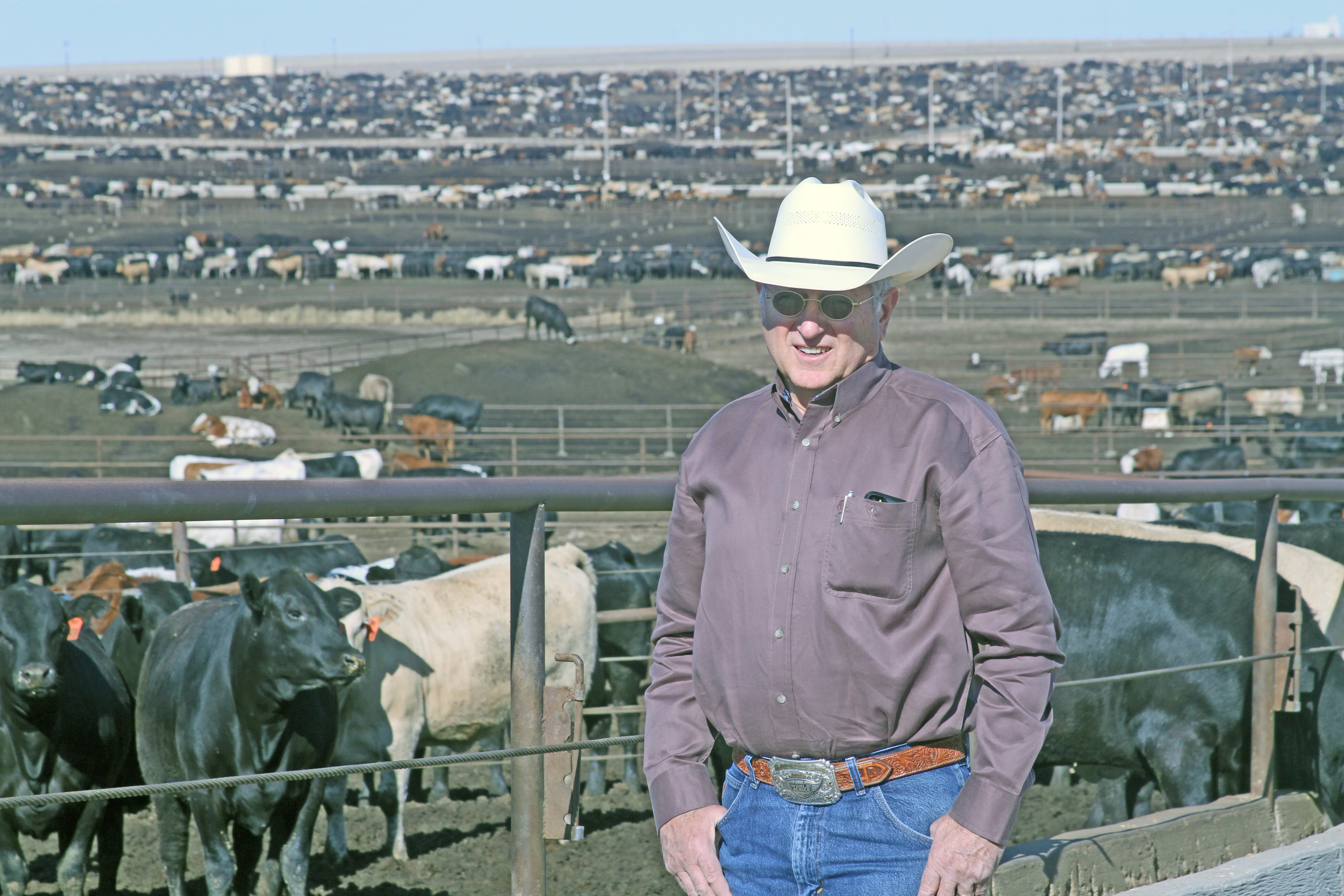Hard Work, Partnerships Bring Expansion for Bar-G Feedyard

Johnny Trotter owner of Bar-G Feedyard in Hereford, Texas, is a busy man. Not only does he manage the day-to-day operations of the 125,000-head capacity yard and keep a crew of 120 motivated, but he also stewards the surrounding land to grow wheat and provide for further expansion, operates a trucking company for shipping livestock and feed, and a cattle financing company. But he doesn’t stop there, Trotter is also owner of a local car dealership, breeds racehorses, owns a racetrack, sits on the boards of several local banks and is a skilled team roper.
Soon, he’ll have a new accolade under his belt as a newly inducted member of the Cattle Feeders Hall of Fame, which will take place in conjunction with the NCBA Convention and Trade Show in August, a title he accepts with humility.
“It’s just who I am and what I do,” Trotter says. “I’m flattered that people voted for me. I’m humbled and really thrilled about it. I appreciate it.”
Trotter has had a lifelong love of horses, but his journey as a cowboy and cattle feeder started with a move to Hereford, Texas. During his sophomore year in high school his family moved from Dumas to Hereford, and he had the chance to work at several different feedyards that were being built. As a senior, Trotter took an opportunity to care for cattle on wheat.
In the ’70s he had the opportunity to lease a preconditioning yard and began backgrounding cattle with several partners, which then eventually led to the purchase of the yard that is now known as Bar-G in January of 1983.
“It had been closed down for four years, and it was in pretty dilapidated shape, but we rebuilt the mill, and we rebuilt the yard and got going with a 40,000 capacity,” he says.
He and Shirley Garrison then put a group of businesspeople together that ran cattle on wheat that would be able to put cattle into the feedyard, including Stanley and David Schaeffer, Harvey Garrison, Eddie and J.W. Sutton and Roy Bryan.
From there, the growth began. Trotter and his partners expanded the yard until it could hold 85,000 head. In 2000 they bought the nearby 7X yard which increased their capacity to the 125,000 it stands at today.

“Shirley Garrison and I were partners for years, and we formed a cattle company together, Bar-G Cattle Company, and that’s what we called the little yard,” Trotter says. “We had a good reputation for keeping calves alive and we had a pretty good following over there for starting cattle on wheat and then bringing them back and growing them.”
That hard work and reputation fueled long-term relationships with packers and crew alike. Trotter has people he’s partnered with or had working for him who have been there for over 35 years.
“I’ve had guys who are retiring now that have been with me over 35 years,” he says. “The people are the main thing, whether it be the customers who fed cattle with us, our guys that partnered with me and believed in me and believed in this company. The ownership of the company has been the same ownership until around the turn of the century, I started buying those guys out.”
“My right-hand man, Kevin Bunch, has been with me since the beginning,” he continues. “People comment about how much we’re alike, but we’ve grown together for almost 40 years now. It’s all about the people. Anytime you hear me say anything, it’s going to be praising the people that have crossed my path, and I don’t feel like that’s an accident, it’s part of God’s plan.”
Investing in technology and adopting new practices for efficiency’s sake has also helped keep Bar-G going. Trotter and his team were one of the first to endorse a turnkey accounting system for feedyards and helped develop its programs.
In addition to improvements in feed tracking and management, shifting from paper feed cards to wirelessly transmitted data coming off the feed truck, Trotter’s crew was one of the first in the industry to ask Temple for a customizable tag.
“We asked for a tag we could print the lot number on, that had the individual number on each tag,” he says. “And that way we color coded the tags, and we had individual tags 25 years ago. We could run a medicine check on cattle we were going to ship and know we weren’t shipping something we shouldn’t. And now, that’s the deal for everybody. I take a little pride thinking that I had something to do with facilitating that.”
Looking at long-term goals for Bar-G, Trotter hopes the packing industry can grow to the point that there’s sustainability, not only for his business, but all operations.
“I would hope that we’ve built an empire here that can be, maybe not under my direction and leadership, but can be sustainable for the next 25 to 30 years,” he says. “I like to think of myself as a progressive, forward-thinking guy, and that’s the reason we put all this farmland together, for the water, because it became obvious to me early on that that would be a limiting factor.”
“We’ve got a relatively good relationship with the packing industry and don’t have any more trouble than a lot of people in marketing the numbers we need to,” he says. “At times it’s difficult, but I hope this enterprise has been constructed in a way that it can be a continuing business for the next 25 to 30 years.”
To those hoping to step into cattle feeding, Trotter’s advice boils down to working hard and being willing to give a helping hand.
“I can’t emphasize enough how far in life a good work ethic will get you,” he says. “As well as being a team player. There’s no limit to what you can achieve when it doesn’t matter who gets the credit. You’ll get a lot further when everyone is playing offense.”
Cattle Feeders Hall of Fame
The Cattle Feeders Hall of Fame was launched in 2009 to celebrate the rich traditions of the cattle-feeding industry and recognize individuals who have devoted their careers to producing safe, quality beef and improving production practices. Merck Animal Health, Osborn and Barr, and Drovers are the founding partners. A reception in August will formally announce the 2021 inductees: Johnny Trotter and Steve Gabel.







